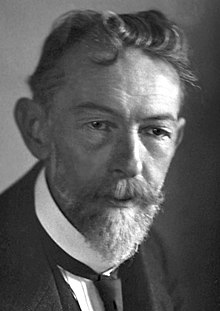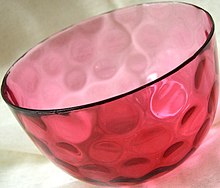Richard Adolf Zsigmondy
Richard Adolf Zsigmondy | |
|---|---|
 | |
| Born | 1 April 1865 |
| Died | 23 September 1929 (aged 64) Göttingen, Germany |
| Alma mater | Technical University of Vienna University of Munich |
| Spouse(s) | Laura Luise Müller |
| Children | 2 |
| Parent(s) | |
| Relatives | Frigyes Schulek (cousin) Dénes Zsigmondy |
| Awards | Nobel Prize in Chemistry (1925) |
| Scientific career | |
| Fields | Chemistry |
| Institutions | University of Vienna Technical University of Vienna University of Munich University of Graz University of Göttingen |
| Doctoral advisor | |
| Influenced | August Kundt |
Richard Adolf Zsigmondy (Hungarian: Zsigmondy Richárd Adolf; 1 April 1865 – 23 September 1929) was an ethnic Hungarian chemist from Austria. He was known for his research in colloids, for which he was awarded the Nobel Prize in chemistry in 1925. The crater Zsigmondy on the Moon is named in his honour.
Biography[]
Early years[]
Zsigmondy was born in Vienna, Austrian Empire, to a Hungarian gentry family. His mother Irma Szakmáry, a poet born in Martonvásár, and his father, Adolf Zsigmondy Sr., a scientist from Pressburg (Pozsony, today's Bratislava) who invented several surgical instruments for use in dentistry. Zsigmondy family members were Lutherans. They originated from Johannes (Hungarian: János) Sigmondi (1686–1746, Bártfa, Kingdom of Hungary) and included teachers, priests and Hungarian freedom-fighters. Richard was raised by his mother after his father's early death in 1880, and received a comprehensive education. He enjoyed hobbies such as climbing and mountaineering with his siblings. His elder brothers, (a dentist) and Emil (a physician), were well-known mountain climbers; his younger brother, Karl Zsigmondy, became a notable mathematician in Vienna. In high school Richard developed an interest in natural science, especially in chemistry and physics, and experimented in his home laboratory.
He began his academic career at the University of Vienna Medical Faculty, but soon moved to the Technical University of Vienna, and later to the University of Munich, to study chemistry under (1848–1899). In Munich he conducted research on indene and received his PhD in 1889.[1]
Career[]

Zsigmondy left organic chemistry to join the physics group of August Kundt at the University of Berlin, and completed his habilitation at the University of Graz in 1893. Because of his knowledge about glass and its colouring, in 1897 the Schott Glass factory offered him a job which he accepted. He invented the Jenaer Milchglas and conducted some research on the red Ruby glass.
Zsigmondy left Schott Glass in 1900, but remained in Jena as private lecturer to conduct his research. Together with the optical instrument manufacturer Zeiss, he developed the slit ultramicroscope. His scientific career continued in 1908 at the University of Göttingen, where he stayed for the rest of his professional career as professor of inorganic chemistry. In 1925, Zsigmondy received the Nobel Prize for Chemistry for his work on colloids and the methods he used, such as the ultramicroscope.
Before Zsigmondy finished his PhD thesis in organic chemistry, he published research on colouring glass with silver salts and dissolved silver particles, which he recovered by dissolving the glass in hydrofluoric acid.

During his stay in Graz, Zsigmondy accomplished his most notable research work, on the chemistry of colloids. The exact mechanism which yields the red colour of the Cranberry or Ruby glass was a result of his studies of colloids.[2] In later years he worked on gold hydrosols and used them to characterize protein solutions. While in Jena he developed the slit ultramicroscope together with Henry Siedentopf. After moving to Göttingen, Zsigmondy improved his optical equipment for the observation of finest nanoparticles suspended in liquid solution. As a result, he introduced the immersion ultramicroscope in 1912.[3]
Private life[]

In 1903 Zsigmondy married Laura Luise Müller, with whom he had two daughters, Annemarie and Käthe. He died a few years after retirement in 1929 in Göttingen, Germany.
He was a cousin of the architect Frigyes Schulek, whose mother was Auguszta Zsigmondy. He is also related to the violinist Dénes Zsigmondy.
Ancestry[]
| Richard Zsigmondy, Vienna (A) 1862–Göttingen (D) 1929 scientist, Nobel Prize Winner in chemistry 1925 |
Father: Adolf Zsigmondy Pressburg/ Pozsony, (HUN) 1816– Vienna (A) 1880 |
Grandfather: Sámuel Zsigmondy Pilis, (HUN) 1788– 1833 Pressburg/ Pozsony (HUN) |
Great-grandfather: G. Zsigmondy Körmöcbánya (HUN) 1748-Pilis (HUN) 1799 |
Great-great-grandfather: J. Zsigmondy Bártfa (HUN) ca 1700 -Körmöcbánya(HUN) 1765 |
Great-great-grandmother: Zsuzsanna Kossovits Besztercebánya (HUN) ? -Lónyabánya (HUN) 1790 |
| Great-grandmother: Judit Polereczky Alberti (Now Albertirsa) (HUN) 1756– 1833 Pressburg/Pozsony (HUN) | |||||
| Grandmother: Friderika Fábry 1793 Pressburg/ Pozsony (HUN)– 1868 Pressburg/Pozsony (HUN) |
grandmother's father: István Fábry (HUN) 1751 – Pressburg/ Pozsony (HUN) 1817 | ||||
| grandmother's mother: Terézia Bayer | |||||
| Mother: Irma von Szakmáry Martonvásár (HUN) 1835 Vienna 1900 |
Mothers father: N.N. von Szakmáry (1818– 1888) |
Mother's grandfather : | |||
| N.N.: | |||||
| Mothers mother: Mária Gegus von Kisgessény ? 1800 Pressburg/ Pozsony (HUN) 18 September 1883[5] |
N.N. : Sámuel Gegus | ||||
| NN: ' |
See also[]
References[]
- ^ Miller, W. V.; Rohde, G. (1889). "Zur Synthese von Indenderivaten". Berichte der Deutschen Chemischen Gesellschaft. 22 (2): 1881–1886. doi:10.1002/cber.18890220227.
- ^ Zsigmondy, R. (1898). "Ueber wässrige Lösungen metallischen Goldes". Justus Liebig's Annalen der Chemie. 301 (1): 29–54. doi:10.1002/jlac.18983010104.
- ^ Mappes, T. (2012). "The Invention of Immersion Ultramicroscopy in 1912—The Birth of Nanotechnology?". Angewandte Chemie International Edition. 51 (45): 11208–11212. doi:10.1002/anie.201204688. PMID 23065955.
- ^ Czeizel, Endre (1992) Családfa Kossuth Könyvkiadó. Budapest, Kossuth. ISBN 963-09-3569-4
- ^ "National Séchenyi Library - Funeral notices - Irma von Szakmáry geb. Gegus obituary".
Further reading[]
- J. Reitstötter (1966). "Richard Zsigmondy". Journal Colloid & Polymer Science. 211 (1–2): 6–7. doi:10.1007/BF01500203. S2CID 197929544.
- "R. Zsigmondy (1865–1929)". Nature. 206 (4980): 139. 1965. Bibcode:1965Natur.206Q.139.. doi:10.1038/206139a0. S2CID 2466716.
- Lottermoser (1929). "Richard Zsigmondy zum Gedächtnis". Zeitschrift für Angewandte Chemie. 42 (46): 1069–1070. doi:10.1002/ange.19290424602.
- "Richard Zsigmondy zum 60. Geburtstage". Zeitschrift für Angewandte Chemie. 38 (14): 289. 1925. doi:10.1002/ange.19250381402.
- H. Freundlich (1930). "Richard Zsigmondy zum 60. Geburtstage". Berichte der Deutschen Chemischen Gesellschaft. 63 (11): A171–A175. doi:10.1002/cber.19300631144.
External links[]
| Wikimedia Commons has media related to Richard Adolf Zsigmondy. |
- Richard Adolf Zsigmondy on Nobelprize.org
 including the Nobel Lecture, December 11, 1926 Properties of Colloids
including the Nobel Lecture, December 11, 1926 Properties of Colloids - Mappes, Timo (2012). "Immersionsultramikroskop nach R. Zsigmondy von Winkel-Zeiss, Göttingen". Immersion ultramicroscope with optics as of the 1912 patent. Retrieved 2012-11-02.
- 1865 births
- 1929 deaths
- 20th-century Austrian chemists
- 20th-century Hungarian chemists
- 20th-century Hungarian physicists
- Hungarian inventors
- University of Göttingen faculty
- Nobel laureates in Chemistry
- Hungarian Nobel laureates
- Austrian people of Hungarian descent
- Scientists from Vienna
- University of Vienna alumni
- TU Wien alumni
- Ludwig Maximilian University of Munich alumni
- Humboldt University of Berlin faculty
- University of Graz faculty
